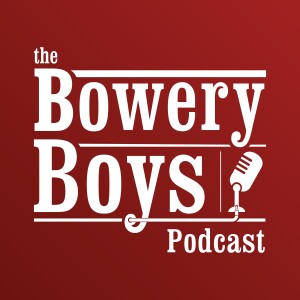
#345 LaGuardia's War on Pushcarts: The Creation of Essex Street Market
 2020-11-13
2020-11-13
Download
Right click and do "save link as"
Once upon a time, the streets of the Lower East Side were lined with pushcarts and salespeople haggling with customers over the price of fruits, fish and pickles. Whatever became of them?
New York's earliest marketplaces were large and surprisingly well regulated hubs for commerce that kept the city fed. When the city was small, they served the hungry population well.
But by the mid-19th century, massive waves of immigration and the necessary expansion of the city meant a lack of affordable food options for the city's poorest residents in overcrowded tenement districts.
Then along came the peddler, pushcart vendors who brought bargains of all types -- edible and non-edible -- to neighborhood streets throughout the city. In particular, on the Lower East Side, the pushcarts created bustling makeshift marketplaces.
Many shoppers loved the set-up! But not a certain mayor -- Fiorello LaGuardia, who promised to sweep away these old-fashioned pushcarts that packed the streets -- and instead house some of those vendors in new municipal market buildings.
For those immigrant peddlers, the Essex Street Market -- in sight of the Williamsburg Bridge -- would provide a diverse shopping experience representing a swirl of various cultures: Eastern European, Puerto Rican, Italian and more.
But could these markets survive competition from supermarkets? Or the many economic changes of life in New York City?
Support the show: https://www.patreon.com/boweryboys
See omnystudio.com/listener for privacy information.
view more
More Episodes
#357 Edith Wharton's New York
 2021-03-26
2021-03-26
 2021-03-26
2021-03-26
#356 Pfizer: A Brooklyn Origin Story
 2021-03-19
2021-03-19
 2021-03-19
2021-03-19
#354 Who Wrote the First American Cookbook?
 2021-03-05
2021-03-05
 2021-03-05
2021-03-05
#353 Harlem Before the Renaissance
 2021-02-26
2021-02-26
 2021-02-26
2021-02-26
Rewind: Harlem Nights at the Hotel Theresa
 2021-02-19
2021-02-19
 2021-02-19
2021-02-19
#352 The Birth of Black Harlem
 2021-02-12
2021-02-12
 2021-02-12
2021-02-12
#351 Auntie Mame (Bowery Boys Movie Club)
 2021-02-04
2021-02-04
 2021-02-04
2021-02-04
#350 The World Trade Center in the 1970s
 2021-01-29
2021-01-29
 2021-01-29
2021-01-29
Rewind: Strange Hoaxes of the 19th Century
 2021-01-22
2021-01-22
 2021-01-22
2021-01-22
Rewind: The Destruction of Penn Station
 2021-01-08
2021-01-08
 2021-01-08
2021-01-08
Rewind: The Construction of Penn Station
 2021-01-01
2021-01-01
 2021-01-01
2021-01-01
#347 Steam Heat! A Gilded Age Miracle
 2020-12-11
2020-12-11
 2020-12-11
2020-12-11
#346 The Beatles Invade New York!
 2020-11-27
2020-11-27
 2020-11-27
2020-11-27
Rewind: The Curious Case of Typhoid Mary
 2020-11-20
2020-11-20
 2020-11-20
2020-11-20
0123456789101112131415161718
Create your
podcast in
minutes
- Full-featured podcast site
- Unlimited storage and bandwidth
- Comprehensive podcast stats
- Distribute to Apple Podcasts, Spotify, and more
- Make money with your podcast
It is Free
- Privacy Policy
- Cookie Policy
- Terms of Use
- Consent Preferences
- Copyright © 2015-2024 Podbean.com



